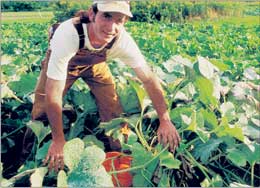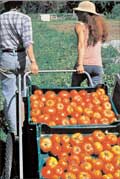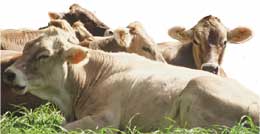
Vermont Fresh Network
|
Know Your Farmer, Share the Harvest Community supported agriculture farms or CSAs give families and individuals the opportunity to partner with a farm to sustain it while sharing in the harvest. Farmers sell "subscriptions," which allow them to gather the money required to maintain their business and focus on the work of cultivating rather than fundraising. A reliable income source allows the farmer to purchase seeds and necessary equipment, regardless of the outcome of the season. In a bountiful year, subscribers benefit richly from continual harvests. Subscribers generally receive weekly produce harvests throughout the growing season. Such harvests vary from farm to farm, depending on the crops planted. CSA subscribers engage in agriculture, forming a bond with those who grow their food. |
It may be cheese that’s melting in their mouths, but what they’re showing the rest of the world is that it’s perfectly possible to eat your landscape. The cheese that Chef Doug Mack uses to make his fondue is created at Orb Weaver Farm in New Haven. The farm is home to a handful of Jersey cows that produce the milk for the fondue cheese. It’s one of many agricultural havens that define the Vermont landscape and nestle among the undulating fields and pastureland of Addison County. If there were no market for the cheese, then there would be no cows, and the open fields could just as easily feature condos as cattle.
The virtue of preserving an "edible landscape" is one of the key ideas behind the Vermont Fresh Network, the organization that nurtures connections like those between Mack and Orb Weaver Farm. The statewide non-profit aims to connect Vermont farmers and food producers with area chefs. This strengthens Vermont agriculture, provides chefs with the freshest ingredients, and helps keep farms in rural areas instead of replacing them with commercial or residential developments.
"By buying local food, chefs are supporting Vermont agriculture, and part of what makes Vermont beautiful is that we still have a working landscape," says Amy Trubek, executive director of Vermont Fresh Network.
 Photo courtesy of Intervale Foundation |
VFN grew out of an idea from Pam Knights of the New England Culinary Institute in the early 1990s. She was interested in supporting the fledgling organic movement that was taking shape and began working with Roger Clapp at the Department of Agriculture on Vermont’s first annual Organic Awareness Day in 1995. The following year they organized "The Vermont Fresh Food Network Forum" for Vermont farmers and chefs and brought in a keynote speaker from the Chefs Collaborative, an organization promoting the use of local, seasonal and sustainable ingredients in restaurants and the wider community. As a result of the interest shown by the more than 100 participants at that event, the Vermont Department of Agriculture and New England Culinary Institute began a formal collaboration to develop the Vermont Fresh Network.
"We are the first organization that tried to create direct marketing between farmers and chefs on a local level. I don’t think there were any others then," says Trubek. While there are similar groups now partnering in other states, there is still no national organization.
These days VFN is a formal, free standing non-profit of 300 members, roughly half of them restaurants and food outlets and the other half farmers and producers. The restaurant and food outlets include both small and large operations, from American Flatbread, tucked in the oven room of the Marbleworks in Middlebury to the Inn at Shelburne Farms, Middlebury College’s Dining Service, and several chic Church Street restaurants in Burlington. The farms also range in size and location. Among the smallest is the Half-Pint Farm in Burlington’s Intervale — a one-acre wonder that produces gourmet baby vegetables from beans and beats through tomatoes and zucchini — while on the larger scale Lilac Ridge Farm in Brattleboro sprawls over 600 acres and sells a range of goods from maple syrup to globe artichokes. The diversity of produce runs the full gamut of farm goods — from honey and syrup, to herbs and fruit, poultry, meat, and dairy. Some are certified organic, others are not, but they are all working with sustainable farming practices centered on keeping farms as part of the overall community. The organization has members statewide, but most are clustered around metropolitan areas such as Burlington, Montpelier, and Middlebury.
 Photo courtesy of Intervale Foundation |
To become a member of VFN farmers must partner at least one restaurant and each restaurant must have a relationship with at least three farms. The VFN creates a list of produce available each week from farmers to help chefs plan their menus and provides some marketing materials to help consumers recognize that the food in VFN sites is locally grown. Members believe that this, and the infinitely fresher flavor of locally grown produce, will keep diners choosing to eat local foods, and thereby sustaining local farms and preserving the landscape.
"When customers come in, they can ask the server where the foods come from, and my server can tell them a little bit about the ranch or the farm and the product, and what we’re doing with it in the kitchen," says Mack, a founding member of VFN who has practiced what he preaches for two decades. He works with 15 farms, all within about 10 miles of Bristol, and changes his menus four times a year to reflect the season and what’s available from local growers.
"The beauty of everyone being in very close proximity to me is distribution is not a problem," Mack says. "The product lasts longer too, because it hasn’t been on a truck for two weeks."
The network helps get the word out about what farmers have available and when, and helps them develop a local market. Bob Hill and Laury Shea bought the 36-acre Clay Brook Farm in Jericho in 1997 and are now growing certified organic vegetables and cut flowers. They have developed a network of marketing opportunities including farmers markets and a Community Supported Agriculture partnership with 75 members. The farm is also a supplier of gourmet vegetables for Butler’s and TheTavern at the Inn at Essex.
 Photo: Marshall Webb |
"They order it from me, I pick it that day and deliver it the same day, so a lot of stuff we do for them are things like micro vegetables — baby squash, baby carrots, and a lot of tomatoes," Hill says.
One of the hardest selling points for local produce is often price, because bypassing centralized distribution companies sometimes means prices are higher. But there’s a bigger picture to the equation that shows a longer term reward for keeping food local, Trubek says.
Vermont Fresh Phone: 229-4706 or 800-658-8787 |
"We’ve gotten used to the idea that we can go to the store and just buy food and not know how it was grown or prepared and believe it’s safe, but there’s increasing evidence that there’s an impact on our health through things like pesticides and the way cattle are raised and slaughtered," she says. "So buying locally is about supporting Vermont agriculture, but it’s also about protecting your family’s health. Since food is this commodity that we put inside our bodies, why not know the person who’s produced your food?"
After nearly a decade in operation, the Vermont Fresh Network continues to grow, not just in members but also in its efforts to find new ways to nurture connections between those who produce the food and those who consume it. The organization is producing a training manual for the food service industry and farmers on how to work with restaurants. At the same time, its biggest challenge remains educating chefs and consumers about the advantages of eating local produce and how to do it. Sometimes that’s a hard nut to crack, but for staunch members like Doug Mack, it’s worthwhile.
"Part of the beauty of the network is that we’re preserving farm space and saving family farms," Mack says. "I love the products and the food and the people doing it, but it also tickles my fancy that we are keeping the land open for Vermont agriculture."
Eve Thorsen is a freelance journalist living in Essex, Vermont.
Now is the time to subscribe. Participating farmers need to have their subscriptions in by the end of May. The list of Vermont farms includes certified organic growers and is available at: www.vermontagriculture.com/csalist.htm. The Department of Agriculture Web site lists farms by location, providing contact information and a map for reference. Subsriptions are currently being accepted.